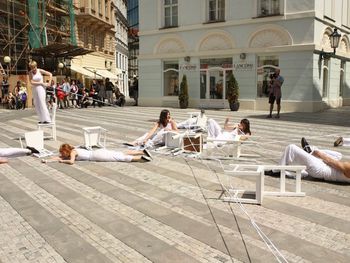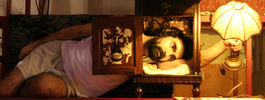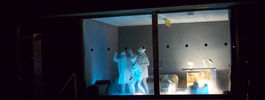

1979 » Canada » Stage and costume design
KANADA
Host of the time when commentators analyze the origins and development of the arts in Canada, they tend to arrive at much the same conclusion: if it is a unique Canadian character, it is influenced by the vast geography of this country, its relatively young age, and the multi-cultural composition of its population. This is decidedly true. The arts in Canada can well be described as diverse and eclectic. However, when looking at the present state of the Canadian theatre and theatre architecture, one discovers a curious fact which indicates that there are certain unique conditions shaping the development of this segment of Canada's cultural spectrum. The fact is that, in the past four years, a very small number of original theatre buildings have been completed, whereas significantly a large number of performance spaces has been created by the restoration and conversion of older and different types of buildings. Financial restrictions are partially responsible for the trend in Canadian theatre architecture towards renovation rather than new construction. 'What this situation indicates is the existence of a distinctly Canadian attitude to the theatre. That attitude is a pioneering spirit and an eternal sense of optimism which leads our artists to see in an old barn or warehouse, a potential theatre and to realize that vision by taking whatever available funds, and transforming an abandoned, lifeless shell into a home for the performing arts. While Canada does not have a long history in the performing arts, we have reached, in a brief time span, the point where the quantity and quality of theatre in this country is as impressive as anywhere else in the world. Twenty-five years ago, theatrical activity was dominated by touring productions of Broadway plays. There were only a handful of professional companies using Canadian talent and staging original work. The Theatre du Nouveau-monde in Montreal, the Jupiter Theatre in Toronto, the Canadian Repertory Theatre in Ottawa and the Shakespearian Festival at Stratford, all were founded in the early fifties, in what is now considered the blossoming of professional theatre in Canada. During the early years, the Stratford Festival was producing in a circus tent, while the others worked out of cinema houses or rented auditoria. These companies were founded with that pioneering spirit, and they have had to rely upon that hardy optimism to remain through the years since. And yet, despite what may look like an inauspicious beginning a brief two and a half decades later, those theatres have now grown to over 1.50 professional producing houses. Since it’s founding in 1953 the Stratford Festival has built a 2.250 seat theatre with a unique design that has been acclaimed and copied in several parts of the world. Other companies such as the Shaw Festival, the Manitoba Theatre Centre, and the Citadel Theatre in Edmonton - which began in borrowed spaces - have since built their own theatres. Many of what are now regarded as major companies in Canada - in Victoria, Vancouver, Calgary, Montreal, Toronto and Halifax - are still producing in converted spaces. And 100 other companies which constitute the ''alternative theatre ''are thriving in every kind of space from warehouses to coffee bars. In London, Ontario, a local amateur theatre company decided to become professional, and has just completed renovations of their' home, a former cinema and vaudeville theatre. In Toronto, three small companies - the Open Circle, the New Theatre and the Theatre du Petit Bonheur - joined forces to convert a former courthouse into a multi-theatre complex. If there are now 15 or 20 established leading professional companies across the country, there is also a significant body of smaller adventurous companies filling the experimental ranks. In many cases, these "alternate“theatres have little more to operate on than that optimism which seems to be our theatre? From all this, there seems a lesson to be learned. If theatre in Canada has reached its present level by virtue of pioneering and optimism, we should have every hope that these qualities will stimulate the growth of an even more dynamic theatre in the years to come. Reinforcing this hope for the continued growth of our theatre is the confidence in the proven excellence of the people who made it grow - such as the five designers whose work is being shown in this Quadrennial exhibit. These designers' work extends to both costumes and settings, and represents the diversity of theatre activity in Canada* Robert PR5V0ST is one of that rare breed - a total theatre artist - whose concept of a production is realized not only through his design elements, but also through his capacity as a director. Michel EAGEN is an extremely active free lance designer whose adaptability is continually challenged by working in a range of theatres* from the largest to the smallest - whose budgets vary as widely as their sizes. Mr. Eagen is also one of those few who works consistently in both French and English language theatres. Sussan BENSON works extensively for one of the country's major theatres, Stratford, which has pioneered the use of the thrust stage. Ms. Benson’s designs reflect the demand of this state and the surround-type placement of the audience, which places heavy responsibility on the importance of the costume design. Cameron PORTEOUS is one of the few resident designers in s major Canadian company, The Playhouse in Vancouver. This situation enables him to work with the same technicians on a succession of productions, end he is able to originate designs of s more exploratory nature. Astrid JANSON's exciting end kinetic designs developed both from the collective approach espoused by Toronto Workshop productions and by their need to rely more on human resources than on large budgets. The individual work of these five designers demonstrates a totally different set of working conditions, design styles, and approaches to the solution of design problems - it is for this reason that we have chosen their work for this exhibit. Regretfully, because of limitations of time and space, we are unable to exhibit the work of many other fine Canadian designers. While this exhibit features five people, there are roughly 100 professional theatre designers in Canada} each of them is an original creative artist. Just as the total activity of theatre production has grown immensely in recent years, so too theatre designers have increased in numbers and range of -work. And Just as Canadian theatre companies have discovered varied styles of production, dependent on the physical condition of their buildings, so Canadian designers have developed a wide variety of individual styles end approaches to design selections, motivated only by the desire to excel. We sincerely hope that you will enjoy this exhibition of Canadian theatre design, and that it will be fitting demonstration of the Canadian spirit.


















































